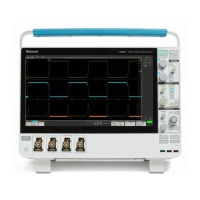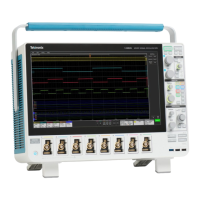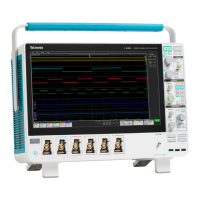Commands listed in alphabetical order
00low
0 1 high
1 1 multiple transitions in interval ending with high
1 0 multiple transitions in interval ending with low
For individual digital channels (such as CH<x>_D<n> ), :DATa:WIDth 2 provides
the 2-bit transition data with the upper 14 bits zero. :DATa:WIDth 1 provides only
the state in the LSB with the upper 7 bits all zero.
For CH<x>_DAll sources, :DATa:WIDth 2 provides the 2-bit transition data
for each of the 8 constituent channels with the D 7 bit represented in the 2 most
significant bits, D6 in the next 2, and so on. :DATa:WIDth 1 provides the states
of eac h of
the 8 constituent channels with D7 represented in the most significant
bit and D0 in the least significant bit.
Dependi
ng on the sample rate, multi-transition data may not be available and
:CURVe? queries for digital channels with :DATa:WIDth 2 may result in a
warning event "Execution warning: Multi-transition d ata not available". In this
case, the transition data returned will be 0 0 or 0 1.
For MATH sources, only 8-byte double precision floating point data is returned in
:CURVe? queries.
Group
Waveform Transfer
Syntax
CURVe
CURVe { <Block>|<asc curve>}
CURVe?
Related Commands
, DATa:SOUrce, DATa:STARt, DATa:STOP, SAVe:WAVEform,,,,WFMOutpre?
Arguments
<Block> is the waveform data in binary format. The waveform is formatted as:
#<x><yyy><data><newline>, where:
<x> is the number of y bytes. For example, if <yyy>=500, then <x>=3)
NOTE. <x> is hexadecimal format. The letters A-F denote several y bytes
between 10 and 15 digits.
<yyy> is the number of bytes to transfer. If width is 1, then all bytes on
the bus are single data points. If width is 2, the n all bytes on the bus are
2-byte pairs. If width is 4, then all bytes on the bus are 4-byte pairs. Use the
command to set the width.
MSO54, MSO56, MSO58, MSO58LP Programmer 2-213

